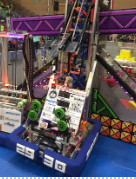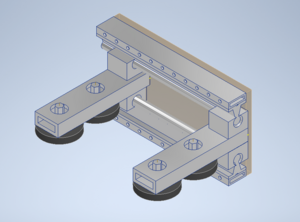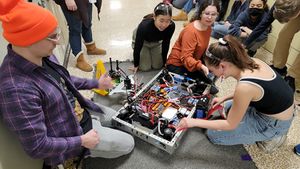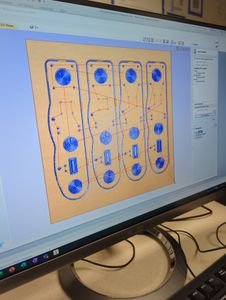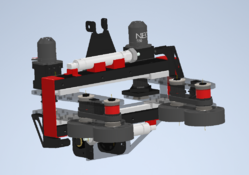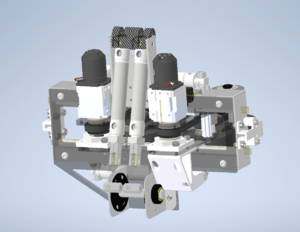2023:Acquisition
Introduction:
Our Subteam, the acquisition team, is part of the larger subteam called Game Piece, in which our team, lift, and robot controls work together to acquire and score both game pieces. Since acquisition is the first mechanism that touches the game piece during an actual match, we decided to get a rough idea of what the acquisition mechanism would look like before beginning the other mechanisms. We ran through the mechanical constraints and robot restriction manuals, and took extensive notes (see below).
Mechanical Constraints
-Although not all of these pertain to acquisition, it was important for every student to understand the limitations of the robot design.
5.8 Game Pieces -
- Cone 1’ and 13/16” (33 cm) tall, 8 and 3/8” ± 1/8” (21 cm) wide, bottom hole is 6 and 5/8” (17 cm) circumference, top hole is 1 ¾” (45 mm) circumference
- - Cube is 9.5” ± ¼” on all sides
5.4 Charging station
- -Charging station: 8ft. ¼ in. (~247 cm) wide, 6ft. 4 1/8 in. (~193 cm) deep structure
- -Main pivoting surface is 8 ft. (~244 cm) wide and 4 ft. (~122 cm) deep. Pivots +/- 15° about the long axis
- -the center of the charging station is 8 ft. 2 5/8 in. (~251 cm) away from the far edge of the GRID’s tape line and centered in the width of the Community
7.1 Robot Restrictions
- - Bumpers need to be low and fully below 7.5” above the ground
- - Bumpers may not fall apart in a way that exposes corners or makes the team number or alliance color undistinguishable
- - Robots can’t intentionally detach or leave parts on the field
- -Start 4’6”
- -Robots can’t be taller than 6’6”
- -Robot maximum frame perimeter is 120 in.
- -Robots can’t extend more than 48” outside of the frame perimeter
- -The robot cannot extend over a curved frame perimeter
- -nothing dedicated to destroying robots or game piece
- --no purpose alliance only in our community zone
- -robots are allowed to grab, grasp, attach to, and deform the game piece (vacuum suction is allowed)
- -robot cannot interfere with field sensors
- -1 game piece can be held at a time
- -Can launch game pieces in community zone
9.2 ROBOT safety and damage prevention
- R201: Do not damage the rugs.
- ITEMS NOT PERMITED:
- Most is common sense but ones that stick out are written below
- -Shields/materials designed or used to obstruct or limit the vision of the drive team and their ability to drive the robot safely
- -Exposed lasers other than class one
- -No EMP jamming devices or devices that can interfere with remote sensing capabilities and no physical objects that can mess with a robot's sensors ex: retro reflective tape
- - “exposed, untreated hazardous materials (e.g., lead weights) used on the ROBOT. These materials may be permitted if painted, encapsulated, or otherwise sealed to prevent contact. These materials may not be machined in any way at an event.”
- - “High intensity light sources used on the ROBOT (e.g., super bright LED sources marketed as ‘military grade’ or ‘self-defense’) may only be illuminated for a brief time while targeting and may need to be shrouded to prevent any exposure to participants. Complaints about the use of such light sources will be followed by re-inspection and possible disablement of the device”
9.3 Budget Constraints and Fabrication:
- - No individual non-KOP item or software should have a Fair Market Value of over $600, but components bought in bulk can cost over $600, if one item doesn’t cost over $600.
- - Fabricated parts made before kickoff are not allowed, but some exceptions are bumpers, fabricated items containing one COTS electrical device, and operator console.
- -During an event the team can only work on their robot or robot elements while the pits are open, unless it is for software development or charging batteries.
- - Create new designs and software, unless they’re available publicly prior to Kickoff
9.4 Bumper Rules:
- -Bumpers should protect all outside corners of the frame perimeter
- - Bumpers must extend at least 6 inches from frame (side cannot be shorter than 6 inches)
- - no more than a .25-inch gap between inside of bumper and outside of frame perimeter- if side is shorter than 12 inches, must be fully covered in bumper
- -Bumpers should stay low, contained within the area from the ground with a volume of 7 ½ in
- -Bumpers should not be able to move, and bumpers should be able to be removed from the robot
- -Bumpers indicate alliance color and team number (number MUST be consisting of white Arabic numerals ONLY, at least 4 in. high, at least ½ in. in stroke width, cannot wrap around corners less than 160 degrees)
- -Bumpers cannot weigh more than 15 lbs. (including any fasteners/things that attach bumpers to robot.)
- -Must be backed by ¾ in. thick plywood, OSB, or solid wood, with the allowance of small mounting holes.
- -Hard bumper parts cannot extend more than 1 in. beyond frame perimeter
- -Pool noodles must be used as a cushion material, and must be covered by a “rugged, smooth cloth)
Important Field Dimensions
- -From edge of Grid to edge of Charging Station: 60.69 in.
- -From edge of Charging Station to Barrier: 59.39 in.
- -From edge of Charging Station to Wall: 59.39 in.
- -Charge Station Platform: 4ft x 8ft
- -Charge Station with ramps: 6ft 4 1/8 in x 8ft 1 ¼ in
- -Height of second level platform: 1ft 11 ½ in
- -Height of second level Cone Node: 2ft 10in
- -Height of third level platform: 2ft 11 ½ in
- -Height of third level Cone Node: 3 ft 10 in
- -Horizontal distance to front edge of second level platform: 1ft 2 ¼ in
- -Horizontal distance to second level cone node: 1ft 10 ¾ in
- -Horizontal distance to front edge of third level platform: 2ft 7 5/8 in
- -Horizontal distance to third level cone node: 3 ft 3 ¾ in
Legacy Research!
-We started by defining the constraints to our mechanisms (ex: frame perimeter, field dimensions, weight limit, etc) to help us evaluate what we can and cannot do. Then, we split into groups, and each designed our own robot. We came up with what we each wanted to see, especially in terms of mechanism concepts. Then, we all met and discussed each mechanism and ranked them on highest interest. After that, we evaluated their practicality and then we used that information to help us decide what ideas to focus on. Next, we did legacy research. We looked at 2011 robots, due to the inflatable game piece, 2015 and 2019, because of the general intake/lift mechanisms and similar movements, and we looked at 2018 robots due to the cubes and the lifts. Next, we looked at VEX 2018 (cones) and FTC 2022 (cones). By the end of our research, we were able to identify the dimensions that we would be operating on the drive base with (11.75 x 10 inch cutout)
After researching, we were able to identify some constraints:
- we can and should fit into our bumper cutout
- We do not need to be larger than our cutout mechanically
- need a strong connection to the lift
- need to keep the weight of the gripper near the back
- try to keep the CoG centered to limit twisting
- pistons are great for this kind of actuation.
Sunday 1/8/23
We started off strong with a small-group brainstorming session, then presenting our ideas to the whole group. We decided on what feature(s) we were sure we wanted on the robot, which would up being swerve. Then, we tested the properties of our game pieces to see how well then could be pushed around and how easily the cone could be flipped. To do this, we used our 2022 robot to simulate our soon-to-be 2023 robot, as they will both have swerve drive bases, as well as a similar bumper height. The Mechanical group also did some conceptual prototyping for the gripper to see what would work best with both the cone and the cube. We decided that our best bet would be to have one gripper for both game pieces so that we didn’t have to worry about switching between two intakes.
Tuesday/Wednesday 1/10/23 - 1/11/23
Over the last two days, we have been heavily focused on prototyping. We have determined the following:
- Green 3" compliance wheels work best for our allocated space
- Ideal cone compression: 4.5 to intake, as tight as possible to pick up cone
- both cones and cubes are best to pickup at 3 inches off the ground
- worked with drive base team to ensure that we have the a mechanism that firs
Thursday 1/12/23
- Our intake prototype is now mounted on a wooden beam, and we experimented with different widths between the wheels of the intake to see what would grab the cone best.
- We found a different type of slider that will most likely be more robust and less wobbly than our current slider, so we may be switching over to that shortly. We also did some calculations and found that 2.75” would be the ideal stroke length for our gripper’s pistons, and we also discovered that the distance between the slide and the wheels needs to be increased significantly (to about 8.5”)
- . We discussed whether it would make more sense to consistently flip the cone no matter what so that the program can stay simpler.
Saturday 1/14/23
Problem Discovered: Our prototype slide was not stable. Had a lot of give in the vertical direction. We dived into the possible causes and discovered the following:
- Our original prototype used drawer slides. Draw slides were not made to handle torque, and considering the weight of the prototype, the force on the end of the mechanism was not easily supported by drawer slides.
- by reinforcing from the back, we gave ourselves only one direction of attachment points.
Some of our solutions included:
- Changing out the drawer slide for linear rails (must purchase)
- For prototyping purposes, adding a channel of 80-20 to replace the drawer slide is more stable
- On the final, attaching to the top and bottom, so that attachment points are in two different directions with two different normal forces acting upon the gripper brackets, we can eliminate some of the wiggle
We began making these adjustments to the prototype, had integration, and then did research into other types of linear rails.
Sunday 1/15/23
We finished the prototype and made the necessary adjustments. We then dived into the testing for the majority of the day. Our results allowed us to learn some critical points.
- When you intake the cone, the cone MUST be lifted off the ground due to the kinetic friction between the cone and the carpet.
- With the cone, we need two positions: first position for a wider grip, allowing less driver precision, and one position to squeeze the cone as tight as we can.
- moving the robot into the cone makes the cone much more likely to tip towards the robot when picking up (solution: add a physical hard stop to stop the rotation of the cone?)
Made necessary changes to the prototype and made a plan to finish the design by Saturday at the latest.
There was a lot of discussion about switching from piston actuation to Lead Screw to give us more variability.
Tuesday/Wednesday 1/17/23 - 1/18/23
Having thought about it more, we think it would probably not be as good of an approach to go with a lead screw design in the gripper. Here were our thoughts.
- It adds more complexity for controls and design, which based on the rest of the complexity of the robot, could stress our ability to pull off the design well.
- It is something that we would not be able to prototype for some time. We would have to source lead screws and that could take some time.
- I think if we went with a cylinder based approach, we could have a functioning gripper much sooner and could iterate on the design faster.
There were also some other gripper prototype configurations that we think would be good to try out to collect more information.
- Try using two wheels per axel to improve gripping on the cone.
- Try a second set of larger diameter wheels in the back of the gripper to increase gripping force as the cone moves farther into the gripper.
- Try the gripper at an angle to the ground to remove the issue of the cone dragging on the ground as the drive base moves forward.
We also had a concept for a prototype that could help with the acquisition of game pieces that might otherwise hit our bumper and bounce off.
- Try over the bumper belts to try to center the cone into the gripper, that are not part of the gripper design.
Testing/Prototyping Reflection:
- The wheels can definitely be sped up and will help things -Right now the one set of wheels is acting like a fulcrum for the cone and spinning under the frame as it contacts the carpet. Two immediate thoughts to solve this are: a second set of harder durometer wheels above the current ones to keep the nose of the cone upright, a rod or “backboard” underneath the gripper to act as a hardstop, or a combination of the two. -If we add a second set of wheels, dropping this first set lower to the carpet will help as well. -Interested to see if bumpers on either side help funnel the game pieces in or cause them to bounce astray -Once we have a gripper frame, we can route the belting so it doesn’t interfere. CNC and an intermediate axle this weekend?
- the 4" wheels gripped the cone better, however they do not fit within our allocated space, so we are going to sacrifice grip in order to properly fit.
- At the end of the night Wednesday, we popped two cubes. It seems as though the cubes got snagged on the back piece of metal and when it got shot out, it ripped.
Thursday 1/19/23
We had our biggest push in detailed design tonight. First, we separated our subteam into three groups!
- Detailed Design
- We finished a basic CAD Design
- Decided to put active wheels at the front of the drive base to allow for us to have a wider reach and a lighter gripper!
- Began adding details, bolts bearings etc
- Communicated with drive and determined the best way to place our intake within the bounds
- communicated with lift subteam to create an attachment plan
- Research for Linear Rails
- we found three linear rails that we liked
- https://www.vevor.com/linear-guide-rail-c_10531/sbr16-1000mm-2-x-linear-rail-4-x-bearing-blocks-cnc-router-bearing-sbr-16uu-p_010694903166?adp=gmc&utm_source=google&utm_campaign=18873377992&utm_term=&gclid=EAIaIQobChMIl_nFjoPV_AIVQhbUAR3YrgpHEAQYASABEgIcevD_BwE&v_tag=ac1582a0-98ca-11ed-9549-6d0614acde99.1
- https://www.amazon.com/OUYZGIA-MGN12H-Printer-Machine-Carriage/dp/B0B1LBV3M3/ref=sr_1_6?crid=35VD3603ZPJ0Z&keywords=linear%2Brail&qid=1674178962&sprefix=linear%2Brail%2Caps%2C85&sr=8-6&th=1
- https://www.amazon.com/GUWANJI-SBR16-1200mm-SBR16UU-Bearing-1200mm/dp/B08BFXBB46/ref=sr_1_3?crid=D8U2S7T4KRUG&keywords=guwanji%2B16mm%2Blinear%2Brail&qid=1674179939&sprefix=guwanji%2B16mm%2Blinear%2Brail%2Caps%2C73&sr=8-3&th=1
- After we met with the entire team, and weighed out the pros and cons, we decided on the second design because it worked better for our parameters of weight, size, and support.
- Prototyping
- We did various prototypes throughout the night. The first one solved the cube popping issue. The second one tested different intake angles to allow for us to lift the cone off the ground so it doesn't drag on the carpet. The last one tested the gripper within the bumper cutout (roughly) to validate that our mechanism fits and functions within context.
Saturday 1/21/23
Today, we finished our 3D CAD Model! We spent the day finalizing the CAD and presented our ideas to the rest of the team at integration. We began collecting all of our parts and made CNC files for all the parts. We CNCed the side plates and the back plate and got ready for assembly tomorrow.
Sunday 1/22/23
We assembled our first version of our intake mechanism today!! Everything worked well, except we discovered that our slider fell apart easily. We may invest in a more expensive, but better option, but we will try to make this one work since we are on a budget.
Tuesday 1/24/23
We finished the piston mounting! We discovered that if we mount our pistons diagonally, we can save a lot of space! We found our ideal piston and stroke length, and then made two circles of mounting pivots which allowed us to find a location that worked with both cube and cone compression with double rotating pistons. We mounted them and finished our prototype. We are planning to test tomorrow. In terms of CAD, we finished the motor mounts and created a piston mount design that we still need to make in CAD. We decided that linear actuation would be the best method for mounting our pistons. Since none of the force will be lost in the vertical direction, we are less likely to bend a stroke if we mount pistons horizontally. We also decided to stick with our current slider because the functionality and price outweighed the maintenance problem. In addition, it only breaks when we take the cart off the slider, which we will never need to do considering we will have backup carts and sliders.
Saturday 1/28/23
We finished our detailed design for CAD! We got our beam breaks mounted, pistons mounted, and are connection to lift secured. We are connecting with brackets and an axle. In addition, we tested our prototype extensively today. From the tests, we decided to pick up cones at a 42 degree angle since it worked the best and lines up with lifts angle. We also decided to go with a wrist pivot function to right tipped over cones. We figured we could use the lift-gripper attachment point as a pivot point, and actuate it with a single piston. We finished the night by confirming details with lift and updating the CAD to reflect this! Here is our mechanism:
</gallery> </gallery>
- Example.jpg
Caption1
- Example.jpg
Caption2
</gallery>
Sunday 1/29/23
Today we focused on shop drawings. We made all the drawings for L3Harris (our main sponsor), correctly formatted the files for all our 3D printed parts, and made changes to the sensor mounts to increase stability. We made sure that all the drawings were done so that we can jump into fabrication on Tuesday. We even manufactured a few axles today!
Tuesday 1/31/23
We worked on finalizing the gripper blades. The new design for the Lexan blade interfered with intaking a game piece so we changed the inside of the intake Lexan blade to ensure there is enough room around the wheels to intake a game piece. Updated and changed CAD. We began to CNC the gripper blades, but the bit broke during the process so we had to order a new bit.
Wednesday 2/1/23
Worked on shop drawings and CAD.
Thursday 2/2/23
We finished all current shop drawings. Began manufacturing of gripper parts. Assigned colors to parts. Started to paint parts.
Saturday 2/4/23
Continued manufacturing gripper parts. Continued painting parts. Started assembly of gripper. Updated shop drawings.
Sunday 2/5/23
Tuesday 2/7/23
Wednesday 2/8/23
Thursday 2/9/23
Saturday 2/11/23
Sunday 2/12/23
Test board
Tuesday 2/14/23
We found out that one piston was not enough to maintain the force for the wrist joint of the gripper so we are going to use 2 pistons instead of just one.
Wednesday 2/15/23
The piece that connected the wrist of the gripper to the lift mechanism was not strong enough so we designed a new piece to be stronger and also include 2 pistons. We also disassembled the gripper mechanism in order to apply updated and newer parts.
Thursday 2/16/23
We reevaluated the connection of the wrist pistons between the gripper and the lift mechanism because there was not enough room for the piston tubing. In order to fix this, we designed a new 3d printed part to attach to the lift. We also had to coordinate with the lift sub team on this to change to change on of their parts in order to compensate for the change in the wrist pistons. We finished painting all of our parts today as well! With everything printed, painted, and fabricated, we are ready to make Version two!

